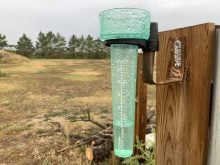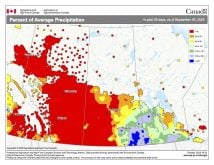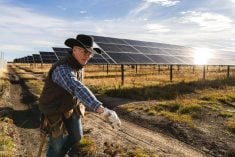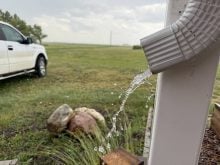The grazing season has had some memorably bad starts in recent years, but 2024 promises to break the cycle across much of the Prairies.
“This is the best start we’ve had for a year for a long time,” said Graeme Finn, founder of Union Forage and rancher near Crossfield, Alta. “These pastures now are looking in pretty good condition going in, pretty much right across the province of Alberta and into western Saskatchewan.”
In particular, producers who destocked after last season and refrained from overgrazing are sitting pretty right now, he said.
Read Also

Moo translator and methane measures: There’s an app for that
Dalhousie University researchers use artificial intelligence to create new dairy farm apps that analyze cattle sounds and measure methane.
It’s a positive change from initial outlooks this spring. Many were bracing for another disastrous year thanks to a string of droughts and little snow cover.
Many areas caught a break in April and May when rain and snow fell across large segments of Western Canada. That included areas of Alberta that had reached critical drought levels in 2023.
“There were some amazing moisture or snow events in areas that were very dry,” said Grant Lastiwka, a forage specialist with Union Forage. “Medicine Hat had four inches of rain. Around Byemoor, it varied from an inch and a half to two inches to four inches, depending on where you were. And there was two feet of wet snow in the Longview and Claresholm areas.”

However, some areas still suffer from moisture deficits.
“The province is up and down,” Lastiwka said. “Some of this (moisture) might help some water bodies in certain places, but not all. The Peace country is still very dry, as I understand.”
The Peace and Manning regions of Alberta saw only an inch or so of rainfall, he noted.
Every bit helps, but “the degree of help is yet to be determined. I know a lot of people have empty water bodies. They’re still addressing a deficit, but it gets us off to a start.”
Saskatchewan
Pasture conditions in Saskatchewan are mixed, but recent rain has improved the picture.
“We were very fortunate in the last couple of weeks that the southern part of the province got enough rain to do some good,” said Garner Deobald of the Saskatchewan Stock Growers Association.
“It buys us some time, but we’re not out of the woods yet. The majority of the province is still short on moisture. The worst areas would be in and around Swift Current, to the west from there and up along the Saskatchewan River.
“It’s been seven or eight years for some of those guys without much precipitation at all.”
Deobald recommends that farmers give pastures time to rest and recover before grazing. That’s a familiar refrain after year-upon-year of abnormally dry weather. Most operations are already trying to do that, he said.
“Where land has been overgrazed, it just takes longer for the grass to re-establish itself. But I think overall people have gotten way better at managing grass.”
Deobald said he’s optimistic about the coming year and hopes recent precipitation is a sign that the dry cycle is ending.
“It’s cyclical. We’ve gone through a number of years of dry weather, and I just get the sense that we’re probably coming to the end of the drought.”
Manitoba
Experts in Manitoba have said they’re also cautiously optimistic about the year.
As of mid-May, precipitation in the easternmost Prairie province sat between 75 and 100 per cent of normal, noted John McGregor, forage expert and extension support with the Manitoba Forage and Grassland Association.

The week leading into the May long weekend brought further rain.
“But we’re going to need more rain to help replenish the soil moisture that we were seeing depleted from five years of dry or drought conditions, depending on where you were in Manitoba,” he said.
Recent weather was cool and cold, which is not conducive to quick regrowth, he noted, but a few days of sustained warm weather would see forage lands substantially improve.
“When I look at the growing degree days, in almost all of the province we are above normal right now,” he said.
Manitoba farmers also ended last year with adequate feed supplies, lessening the temptation to graze cows too early.
“We got rains last fall that allowed cattle to do some late-fall grazing. We had a very mild winter, which didn’t use up as much of the feedstocks as we would normally see in a normal Manitoba winter,” said McGregor.
“In most cases, we are seeing producers with a slight surplus of feed on hand right now.”















